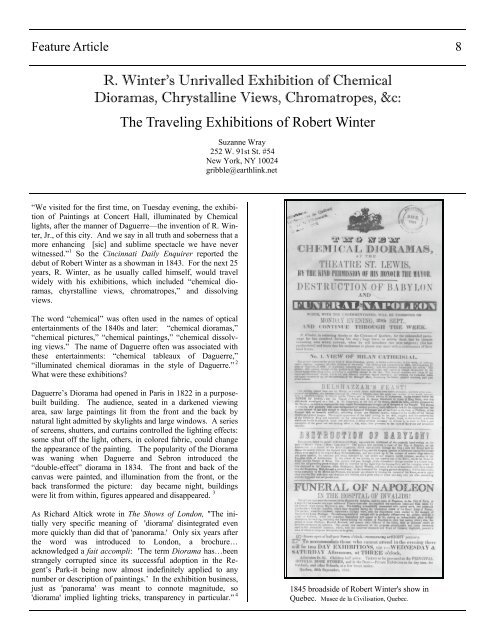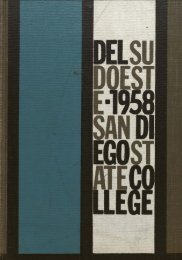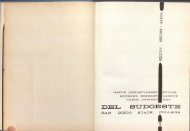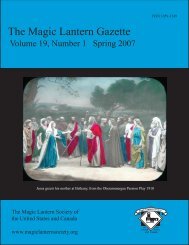The Magic Lantern Gazette - Library
The Magic Lantern Gazette - Library
The Magic Lantern Gazette - Library
Create successful ePaper yourself
Turn your PDF publications into a flip-book with our unique Google optimized e-Paper software.
Feature Article 8<br />
R. Winter’s Unrivalled Exhibition of Chemical<br />
Dioramas, Chrystalline Views, Chromatropes, &c:<br />
<strong>The</strong> Traveling Exhibitions of Robert Winter<br />
Suzanne Wray<br />
252 W. 91st St. #54<br />
New York, NY 10024<br />
gribble@earthlink.net<br />
“We visited for the first time, on Tuesday evening, the exhibition<br />
of Paintings at Concert Hall, illuminated by Chemical<br />
lights, after the manner of Daguerre—the invention of R. Winter,<br />
Jr., of this city. And we say in all truth and soberness that a<br />
more enhancing [sic] and sublime spectacle we have never<br />
witnessed.” 1 So the Cincinnati Daily Enquirer reported the<br />
debut of Robert Winter as a showman in 1843. For the next 25<br />
years, R. Winter, as he usually called himself, would travel<br />
widely with his exhibitions, which included “chemical dioramas,<br />
chyrstalline views, chromatropes,” and dissolving<br />
views.<br />
<strong>The</strong> word “chemical” was often used in the names of optical<br />
entertainments of the 1840s and later: “chemical dioramas,”<br />
“chemical pictures,” “chemical paintings,” “chemical dissolving<br />
views.” <strong>The</strong> name of Daguerre often was associated with<br />
these entertainments: “chemical tableaux of Daguerre,”<br />
“illuminated chemical dioramas in the style of Daguerre.” 2<br />
What were these exhibitions?<br />
Daguerre’s Diorama had opened in Paris in 1822 in a purposebuilt<br />
building. <strong>The</strong> audience, seated in a darkened viewing<br />
area, saw large paintings lit from the front and the back by<br />
natural light admitted by skylights and large windows. A series<br />
of screens, shutters, and curtains controlled the lighting effects:<br />
some shut off the light, others, in colored fabric, could change<br />
the appearance of the painting. <strong>The</strong> popularity of the Diorama<br />
was waning when Daguerre and Sebron introduced the<br />
“double-effect” diorama in 1834. <strong>The</strong> front and back of the<br />
canvas were painted, and illumination from the front, or the<br />
back transformed the picture: day became night, buildings<br />
were lit from within, figures appeared and disappeared. 3<br />
As Richard Altick wrote in <strong>The</strong> Shows of London, "<strong>The</strong> initially<br />
very specific meaning of 'diorama' disintegrated even<br />
more quickly than did that of 'panorama.' Only six years after<br />
the word was introduced to London, a brochure…<br />
acknowledged a fait accompli: '<strong>The</strong> term Diorama has…been<br />
strangely corrupted since its successful adoption in the Regent’s<br />
Park-it being now almost indefinitely applied to any<br />
number or description of paintings.’ In the exhibition business,<br />
just as 'panorama' was meant to connote magnitude, so<br />
'diorama' implied lighting tricks, transparency in particular.” 4<br />
1845 broadside of Robert Winter's show in<br />
Quebec. Musee de la Civilisation, Quebec.
















